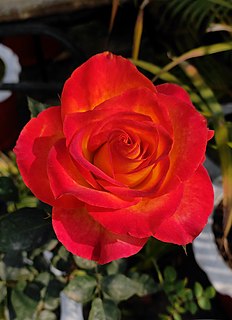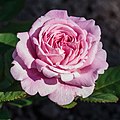History
Pernet-Ducher
Joseph Pernet was born near Lyon, France, in 1859. His father, Jean Pernet, (1832-1896) was a successful nurseryman and a 2nd generation rosarian. Joseph worked at his father's nursery until 1879, when he was hired as an apprentice by nursery owner and rose breeder, Claude Ducher. Ducher introduced many rose cultivars in the 1800s, including the Hybrid Perpetual 'Gloire de Ducher' and two popular Tea roses, 'Marie van Hourte' (1871) and 'Anna Olivier' (1872). After Ducher's death in 1874, his widow, Marie Serlin Ducher (1834-1881) promoted Pernet to nursery foreman. Pernet married Ducher's daughter, Marie, in 1882 and took the name "Pernet-Ducher.
During the 1880s, Pernet-Ducher and Jean Pernet developed a rose breeding program to develop a new class of Hybrid teas and create a remontant, deep yellow Hybrid perpetual. The only yellow roses at the time were pale yellow or buff colored. They bred their new rose varieties using controlled pollination with great success and were able to create many popular new cultivars, including 'Madame Caroline Testout' (1890) and 'Mme Abel Chatenay' (1895).
"This must once have been the most popular rose in the world. 'Madame Caroline Testout' was planted in such quantities along the sidewalks of Portland, Oregon that it became known as 'America's Rose City'"
— Quest-Ritson, 2011.
In 1887, Pernet-Ducher and Pernet crossed the red Hybrid perpetual, 'Antoine Ducher' with Rosa foetida , which Pernet-Ducher selected for its bright, long-lasting yellow color. One seedling survived the hybridization process and was planted in Pernet-Ducher's garden. Two years later, he noticed a new seedling growing alongside the original Foetida hybrid planting. It grew to be an exceptional floriferous rose with large blooms and a unique and beautiful blended color of pink, peach, yellow, and apricot. He named the seedling 'Soleil d'Or' (golden sun).
After Jean Pernet died in 1896, Pernet-Ducher continued their rose breeding program. He introduced 'Soleil d'Or' on November 1, 1900. All modern yellow roses are descended from this cultivar, which is the first of the Pernetiana rose class and the ancestor of all modern Hybrid tea roses. 'Soleil d'Or' was not the peak of Pernet-Ducher's career. He continued to develop new roses, crossing 'Soleil d'Or' with many hardy Tea roses, with the goal of improving hardiness, flowering and the introduction of new color varieties. During his long career, Pernet-Ducher created an entirely new range of rose colors, introducing bright yellows, apricots, copper, new orange shades, lavender, new blended colors and bicolors.
'Madame Caroline Testout'
'Mme Caroline Testout' was bred by Pernet-Ducher in 1890 by crossing the light pink tea roses, 'Madame de Tartas' and 'Lady Mary Fitzwilliam'. The rose was named after Madame Caroline Testout, a late 19th-century French dressmaker from Grenoble, and the owner of fashionable salons in London and Paris. To gain publicity for her salon businesses, Madame Testout asked Perner-Ducher to name one of his new roses after her. The new rose was first introduced at Madame Testout salon's 1890 spring fashion show. It was very popular in both Europe and the United States, receiving wide acclaim for its floriferous and satiny, rose-pink flowers. In Portland, Oregon in the early 1900s, 'Mme Caroline Testout' shrubs were planted in the hundreds of thousands along its city streets. This rose is recognized by the city of Portland as being an important contributor to its worldwide reputation as the "City of Roses". [9] [10]

Hybrid tea is an informal horticultural classification for a group of garden roses. The first hybrid tea roses were created in France in the mid-1800s, by cross-breeding the large, floriferous Hybrid Perpetuals with the tall, elegant Tea roses. The Hybrid tea is the oldest class of Modern garden roses. Hybrid teas exhibit traits midway between both parents, being hardier than the often delicate Tea roses, and with a better ability for repeat-flowering than the more robust Hybrid Perpetuals.

Jean Claude Pernet, père was a French nurseryman and rose breeder, best known for his Hybrid Perpetual and Bourbon rose varieties. His most popular roses include 'Baroness Rothschild' (1868), 'Merveille de Lyon (1882), and 'Triomphe des Noisettes' (1887). His father, Claude Pernet, and son Joseph Pernet-Ducher were also influential nursery owners and rose breeders.

Joseph Pernet-Ducher (1859–1928) was a French rose breeder who is recognized for his work in the development of the modern Hybrid tea rose. Pernet and his father, Jean Pernet, worked together in the 1880s to develop the first yellow remontant Hybrid perpetual rose. After Jean Pernet's death in 1896, Pernet-Ducher continued their work and later introduced 'Soleil d'Or' in 1900. 'Soleil d'Or' initiated a new class of tea roses known as Pernetiana roses and is considered the ancestor of the modern Hybrid tea rose.

The Peace rose, formally Rosa 'Madame A. Meilland', is a well-known and successful garden rose. By 1992, over one hundred million plants of this hybrid tea had been sold. The cultivar has large flowers of a light yellow to cream color, slightly flushed at the petal edges with crimson-pink. It is hardy and vigorous and relatively resistant to disease, making it popular in gardens as well as in the floral trade.

Rosa 'La France' is a pink rose cultivar found in France in 1867 by the rosarian Jean-Baptiste André Guillot (1827–1893). It is generally accepted to be the first hybrid tea rose. Its introduction is therefore also considered the birth of the modern rose. As the cultivar was not systematically bred, its hybrid parentage can only be speculated, but 'Madame Falcot' is considered as a possible parent.

Pedro Dot (1885–1976) was a Spanish rose breeder.

Garden roses are predominantly hybrid roses that are grown as ornamental plants in private or public gardens. They are one of the most popular and widely cultivated groups of flowering plants, especially in temperate climates. An enormous number of garden cultivars have been produced, especially over the last two centuries, though roses have been known in the garden for millennia beforehand. While most garden roses are grown for their flowers, often in dedicated rose gardens, some are also valued for other reasons, such as having ornamental fruit, providing ground cover, or for hedging.

Rosa 'Wife of Bath', is a pink rose cultivar developed by David C.H. Austin in England in 1969. It was one of his early cultivars and is named after a character from Geoffrey Chaucer's The Canterbury Tales. 'Rosarium Glücksburg' is a rose garden in the park of Schloss Glücksburg in Glücksburg, Germany.

Rosa 'Cécile Brünner', also known as 'Mlle Cécile Brünner', 'Sweetheart Rose', 'Malteser Rose', or 'Mignon', is a light pink polyantha rose bred in France by Marie Ducher and introduced by her son-in-law, Joseph Pernet-Ducher in 1881. Its parents were a double-flowered R. multiflora and a hybrid tea rose, either 'Souvenir d'un Ami' or a seedling of 'Mme de Tartas'. It is not clear if the rose was named after the sister (1853–1927) or daughter of Ulrich Brunner fils.

Rosa 'Diamond Jubilee' is a light yellow Hybrid tea rose developed in the United States in 1947 by Gene Boerner. The cultivar was named All-America Rose Selections (AARS) winner in 1948.

Rosa 'Queen Elizabeth' is a pink Grandiflora rose cultivar, bred by rose grower, Dr. Walter Lammerts in the United States in 1954. The rose variety is very popular worldwide and has won numerous awards, including "World's Favorite Rose", (1979).

Rosa 'Apricot Nectar' is a hybrid tea rose cultivar, bred by Eugene Boerner before 1964. The plant is considered very easy to grow and is well-known for its attractive pale apricot pink color. It was named an All-America Rose Selections (AARS) winner in 1966.

Rosa 'Primevère' is a yellow hybrid wichurana, a large-flowered climbing rose. The cultivar was bred by French rose breeder, René Barbier in 1929. It is thought to be the best yellow large-flowered Wichurana rambler.

Rosa 'Soleil d'Or' is a Foetida hybrid rose cultivar, bred by Joseph Pernet-Ducher and introduced on November 1, 1900. It is the ancestor of all modern Hybrid tea roses and the first yellow-orange rose. Pernet-Ducher later crossed 'Soleil d'Or' with Tea roses to create a new class known as Pernetiana roses.

Rosa 'Souvenir de Claudius Pernet' is a medium yellow Hybrid tea rose, bred by French rose breeder, Joseph Pernet-Ducher before 1919. He named the rose for his son Claudius, who was killed in action in World War I. 'Souvenir de Claudius Pernet' is one of the ancestors of the famous 'Peace' rose.

Rosa 'Margaret McGredy' is an orange-red hybrid tea rose, bred by Irish rose breeder Sam McGredy III before 1925. The new rose was awarded the Royal National Rose Society (RNRS) Gold Medal in 1925, but was never commercially successful. 'Margaret McGredy, along with an unnamed seedling, was used to hybridize the legendary hybrid tea rose, 'Peace'.

Rosa 'Joanna Hill' is a yellow hybrid tea rose, bred by American rose breeder, Joseph H. Hill in 1928. 'Joanna Hill is one of the ancestors of the legendary hybrid tea rose, 'Peace'.

Joseph Rambaux (1820–1878) was a gardener and rose breeder from Lyon, France. He is considered the patriarch of the legenday Meilland family, award-winning rose breeders for six generations. The rose variety he is best remembered for is the Polyantha, 'Perle d'Or', introduced in France in 1883. 'Perle d'Or' was granted several awards, including the Lyon Gold Medal in 1883, and the Royal Horticultural Society's Award of Garden Merit in 1993.

Rosa 'Baroness Rothchild' is a pink Hybrid Perpetual rose cultivar, bred by Jean Pernet in 1868 and introduced in Australia by St. Kilda Nurseries in 1873 as 'Baroness Rothschild'.




















